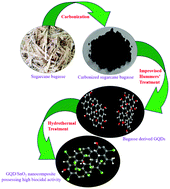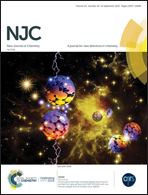Biowaste derived graphene quantum dots interlaced with SnO2 nanoparticles – a dynamic disinfection agent against Pseudomonas aeruginosa†
Abstract
Highly resilient antibacterial strains are a major cause of concern in the modern sewage treatment and sanitation industry. Hence, development of efficient, low-cost disinfectant agents is essential. In this study, synthesis of graphene quantum dots (GQDs) from expended sugarcane bagasse via surface functionalization and the subsequent production of GQD/SnO2 nanocomposites via a facile hydrothermal route is demonstrated for the first time. The synthesized nanostructures are found to be studded with various oxygen moieties and exhibit an excitation independent fluorescence behaviour implying the existence of quantum confinement effects. Nanoparticles obtained after the hydrothermal treatment are found to possess spherical morphology with an average particle size of 4.5 nm. Antibacterial activity of the synthesized product is tested against Pseudomonas aeruginosa using the disc diffusion assay and minimum inhibitory concentration assay. A marked rise in the antibacterial performance is seen in the nanocomposite compared to its carbonized and GQD counterparts. This can be attributed to the presence of surface defects and smaller uniform sized particles. These cost-effective nanostructures are photo stable for extended periods of storage and may find excellent utility in the sanitation and disinfectant industry.



 Please wait while we load your content...
Please wait while we load your content...